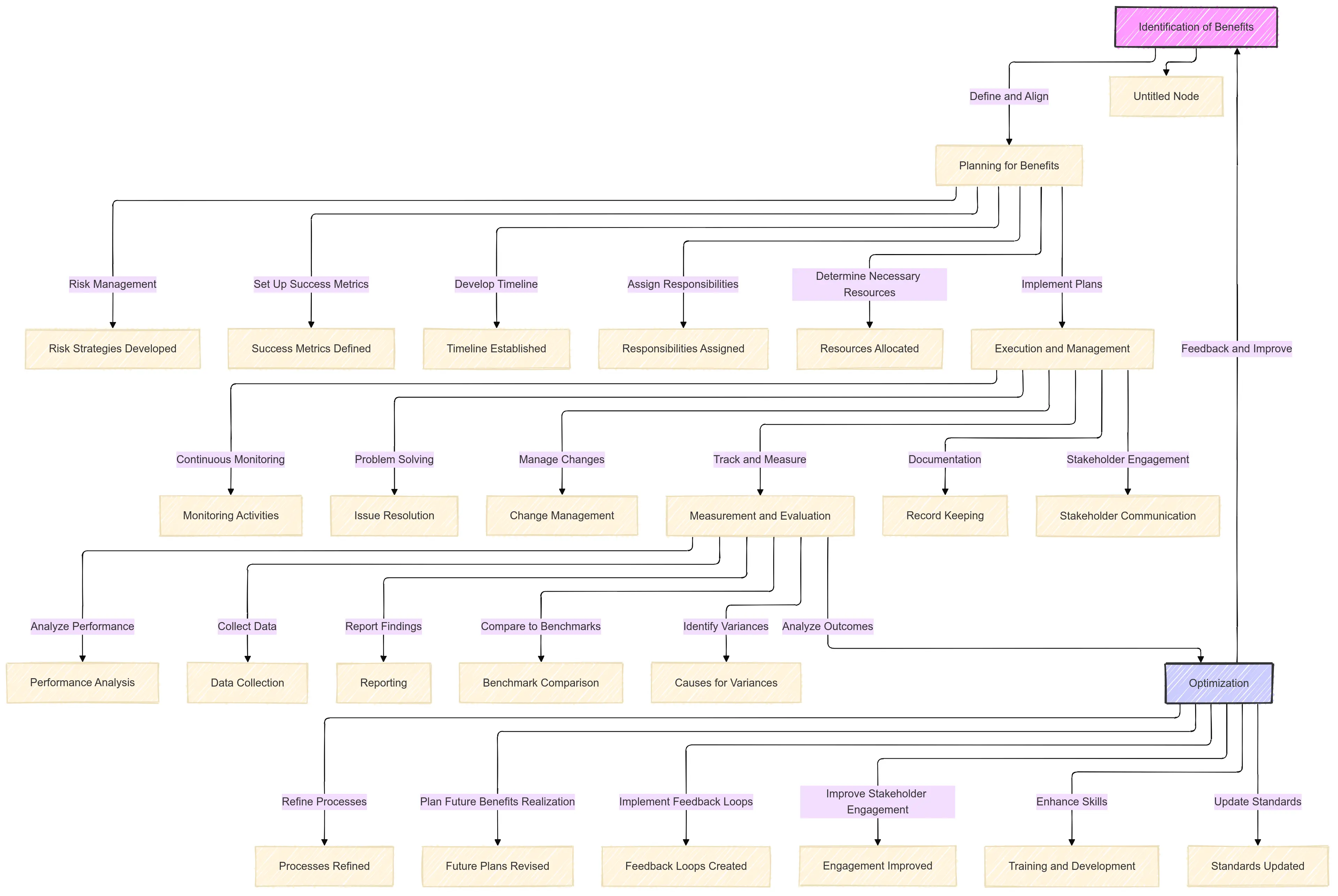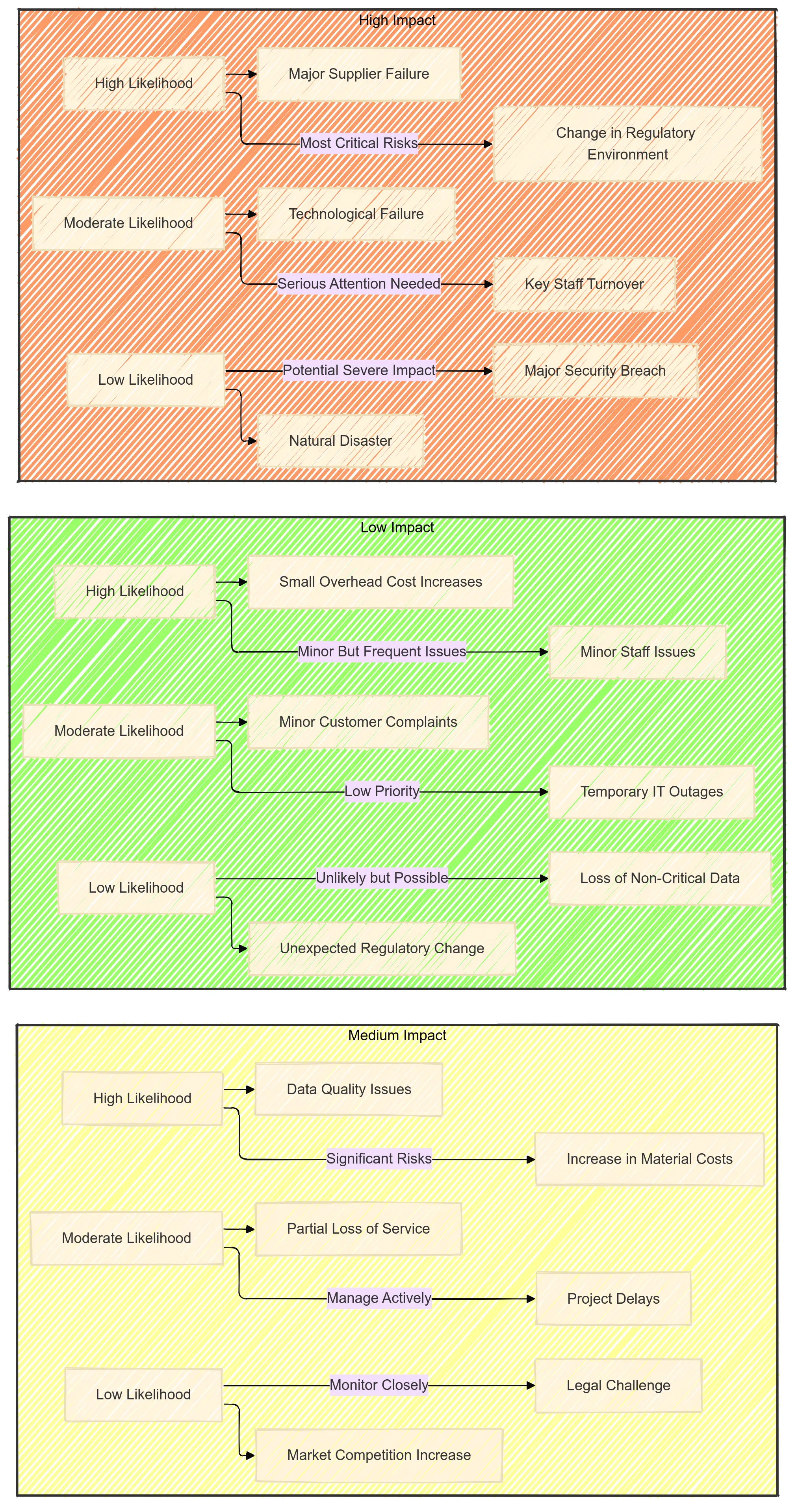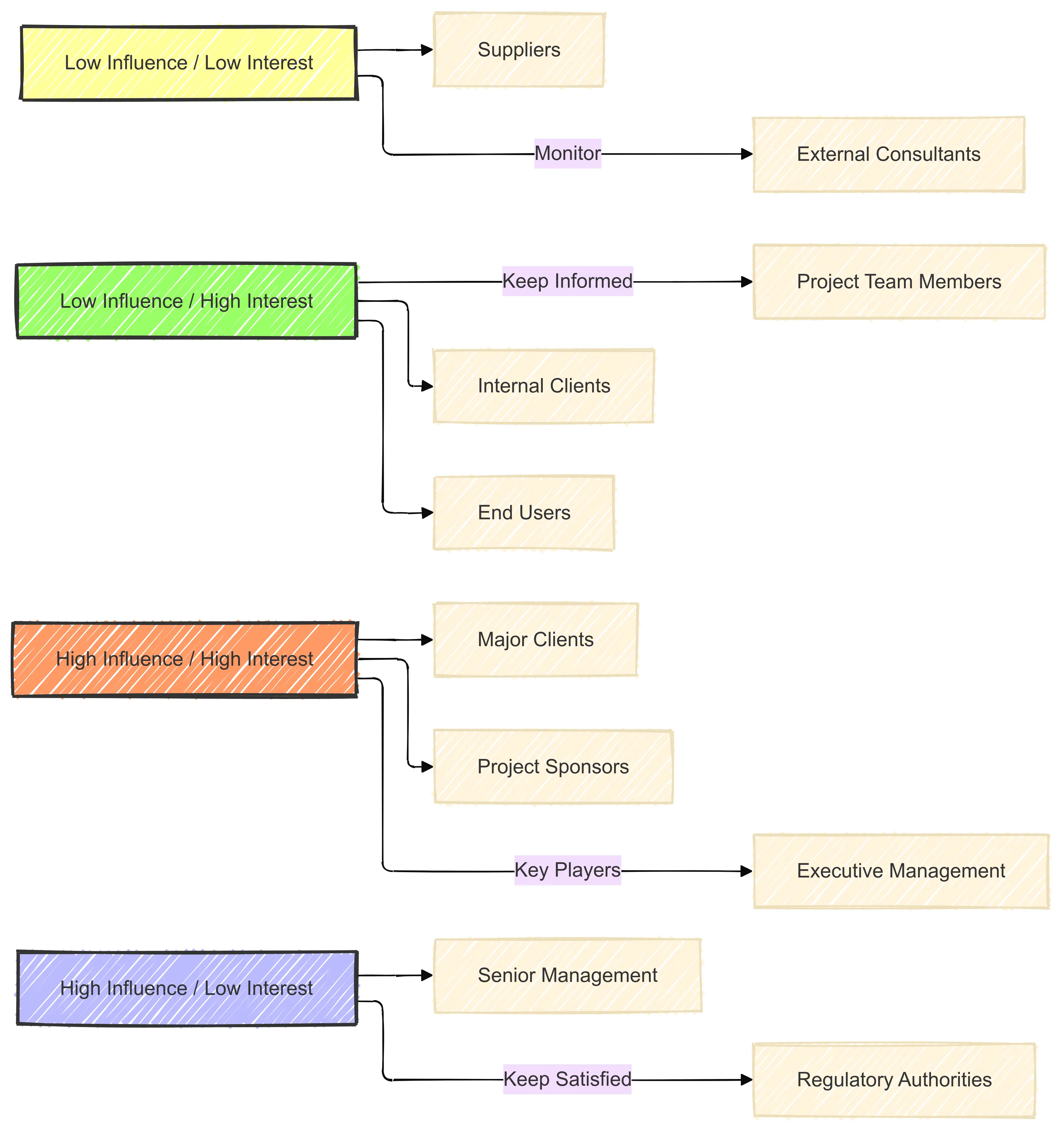Understanding Benefits Realization Management
Saturday November 09, 2024



In the vast realm of program management, the concept of benefits realization stands as a cornerstone, ensuring that projects not only meet their deadlines and budget constraints but also deliver substantial value to the organization. This process aligns project outcomes with the strategic goals of an organization, making it essential for achieving long-term success. In this guide, we’ll explore what benefits realization entails, the steps involved, and how to overcome common challenges, with practical examples and links to further resources.
At its core, benefits realization is about ensuring that any project or program undertaken by an organization delivers the expected advantages, which should align with the broader strategic objectives. These benefits might include increased efficiency, cost savings, enhanced customer satisfaction, or new revenue streams.
Identifying the benefits that a project or program aims to deliver is the foundational step in the Benefits Realization Management (BRM) process. This step requires a clear understanding and articulation of the expected advantages that are aligned with the organization’s strategic objectives. These benefits should be Specific, Measurable, Achievable, Relevant, and Time-bound (SMART) to ensure they are realistic and can be evaluated effectively.
Specific: Benefits should be well-defined and clear to all stakeholders involved. For example, rather than saying “improve customer satisfaction”, specify “increase customer satisfaction ratings by 20% on service delivery surveys.”
Measurable: Each benefit should have a corresponding metric that can be used to assess progress and achievement. In the case of a software implementation project, a measurable benefit could be “reduce the average process time by 15% within one year after deployment, as measured by transaction logs.”
Achievable: The benefits should be attainable within the scope of the project’s resources and capabilities. This involves realistic goal-setting based on the organization’s capacity and past performance.
Relevant: The benefits must align with the broader organizational goals and have a direct impact on its strategic direction. For instance, if a company’s objective is to enhance operational efficiency, a relevant benefit could be the automation of manual tasks to free up staff for higher-value activities.
Time-bound: Benefits should have a clear timeline for when they are expected to be realized. This not only provides a target for project teams but also helps in prioritizing resources and efforts effectively.
To further illustrate, consider a healthcare provider aiming to implement a new electronic health record system. The identified benefits could include “reduce patient wait times by 30% within six months of system go-live” and “achieve a 25% decrease in data entry errors within one year.” These clearly defined, measurable, achievable, relevant, and time-bound benefits ensure that the project is strategically aligned and sets the stage for the subsequent phases of the BRM process.
Incorporating stakeholder input during the identification phase is crucial. Engaging with end-users, management, and other stakeholders can provide insights into what benefits are most valued and how they might best be realized, thus enhancing the overall success of the project.

Once the benefits of a project or program have been identified, the next critical step in BRM is meticulous planning. This stage sets the foundation for how the identified benefits will be achieved and sustained over time. Effective planning involves several key components, each contributing to the strategic alignment and eventual success of the project.
Setting Up Success Metrics: For each identified benefit, corresponding success metrics must be established. These metrics serve as the benchmarks against which the achievement of benefits will be measured. For example, if a benefit involves reducing operational costs by 10%, the success metric might include specific financial targets or percentage reductions in various cost categories.
Assigning Responsibilities: It is vital to clearly define who is responsible for delivering each benefit. This involves assigning ownership to specific team members or departments. Ownership ensures accountability and provides clear points of contact for each benefit area. Responsibilities should be aligned with the skills and roles of the assigned personnel to optimize the chances of successful benefits realization.
Determining Necessary Resources: Planning must also address the resources required to achieve the identified benefits. This includes budgeting for financial resources, allocating human resources, and arranging for technological or infrastructural support. A detailed resource plan helps prevent resource shortages and conflicts during the execution phase.
Developing a Timeline: Each benefit should have a defined timeline that outlines key milestones and deadlines. This timeline not only guides the project execution but also helps stakeholders track progress against expected timeframes. For instance, if a new software implementation is expected to improve processing speed, the timeline might specify stages for software customization, testing, deployment, and full utilization.

Risk Management: Identifying potential risks that could impede the realization of benefits is a crucial part of the planning process. Risk management strategies should be developed to mitigate these risks. This might include contingency planning, risk transfer methods, or risk avoidance strategies, depending on the nature of the identified risks.
Utilizing Tools and Methodologies: To aid in effective planning, several tools and methodologies can be leveraged. The Project Management Institute (PMI) offers a plethora of resources, including guidelines, templates, and best practices that can enhance the planning process. These tools are designed to streamline planning and ensure that it is comprehensive and aligned with industry standards.
Engagement and Communication: Throughout the planning phase, it is essential to maintain open lines of communication with all stakeholders. Regular updates, meetings, and feedback sessions help ensure that the plan remains aligned with organizational goals and that any changes in the project scope or external environment are promptly addressed.
By thoroughly addressing these components, the planning phase can set a solid foundation for the effective realization of project benefits, aligning closely with the strategic goals of the organization and ensuring that all preparatory steps enhance the likelihood of success.
The execution and management phase of BRM is where planning transitions into action. This phase is critical for ensuring that the project’s activities are aligned with the planned benefits and that these benefits are actively pursued throughout the project lifecycle.
Integration of Plans into Project Activities: The initial step in this phase is to integrate the benefits realization plan with the day-to-day project activities. This ensures that every task and milestone directly contributes towards achieving the defined benefits. For example, if a benefit involves enhancing customer experience through a new digital interface, project tasks should include user design, testing, and feedback loops specifically aimed at optimizing the user experience.
Continuous Monitoring: Constant monitoring is essential to track the progress of benefits realization. This involves regular reviews of performance against the success metrics set during the planning phase. Monitoring tools and dashboards can be highly effective in providing ongoing visibility into how well the project is aligning with its intended benefits. Techniques such as Earned Value Management (EVM) can be employed to measure project performance and progress in an objective manner.
Managing Changes Effectively: Projects are dynamic, and changes are inevitable. Effective management of these changes is crucial to ensure they do not derail the benefits realization. A structured change management process should be in place to evaluate the impact of any proposed changes on the project’s benefits. This process should involve reassessment of benefits, realignment of resources, and adjustment of timelines as necessary.

Stakeholder Engagement and Communication: Keeping all stakeholders informed and engaged throughout the project execution is vital for the success of BRM. Regular updates, meetings, and reports should be used to communicate progress, address concerns, and gather feedback. This engagement ensures that stakeholders support the project and contribute to the continuous alignment of project activities with strategic benefits.
Problem Solving and Decision Making: During project execution, challenges and obstacles to benefits realization will inevitably arise. Effective problem solving and decision-making processes must be in place to address these issues promptly. This may involve strategic decisions about resource reallocation, schedule adjustments, or even changes in project scope, always with the aim of preserving or enhancing the project’s ability to deliver benefits.
Documentation and Record Keeping: Maintaining comprehensive documentation is crucial during the execution phase. This documentation should record all decisions made, changes implemented, and issues encountered and resolved. These records are not only essential for auditing and post-project reviews but also provide valuable lessons that can be applied to future projects.
By diligently applying these practices, the execution and management phase can effectively translate plans into actions that maximize project benefits. This phase is not just about adherence to plans but also about adapting to new information and conditions while keeping the focus on strategic objectives.
The measurement and evaluation phase is crucial in BRM, as it determines whether the project or program has achieved its intended benefits. This phase involves systematic tracking and analysis of outcomes against the predefined key performance indicators (KPIs) and metrics established during the planning phase. Here are the key components of an effective measurement and evaluation process:
Collecting Data: The first step is the systematic collection of data related to the identified KPIs. This data provides the factual basis for evaluating the achievement of benefits. For example, if a benefit involves increasing production efficiency, data collection would focus on metrics such as production time, output rates, and resource utilization before and after project implementation.
Analyzing Performance: With data in hand, the next step is to analyze it to assess performance against the expected benefits. This analysis should consider both quantitative and qualitative data to provide a comprehensive view of the outcomes. Tools such as statistical analysis software, dashboards, and performance reporting systems can be instrumental in this process.
Comparing Results to Benchmarks: The core of the evaluation involves comparing the actual outcomes to the benchmarks set in the planning phase. This comparison highlights areas where the project succeeded, met, or fell short of its objectives, providing clear insights into the effectiveness of the project in delivering benefits.
Identifying Variances and Their Causes: When discrepancies between expected and actual outcomes are identified, it is important to explore and understand the reasons behind these variances. Factors such as changes in project scope, resource limitations, external influences, or deviations from the plan can affect the results. Understanding these factors is crucial for accurate evaluation and for learning from the experience.
Reporting Findings: Communicating the results of the evaluation to stakeholders is essential. Reports should be clear, concise, and tailored to the audience, whether they are project team members, executives, or external stakeholders. These reports not only inform about the success or shortcomings of the project but also provide evidence and justification for future decision-making processes.
Revising Future Plans: Based on the findings from the measurement and evaluation phase, plans for future projects can be adjusted and improved. This may involve refining the benefits realization process, adjusting KPIs, or altering methodologies to better achieve desired outcomes in future initiatives.
Lessons Learned: An integral part of this phase is the extraction of lessons learned, which can be applied to improve the management and execution of future projects. This involves documenting insights related to both the successes and challenges encountered, which can guide the planning and execution of subsequent projects.
By effectively measuring and evaluating project outcomes, organizations can ensure that they not only recognize the successes and shortcomings of their initiatives but also continually enhance their capacity to deliver meaningful benefits aligned with their strategic objectives.
Optimization is the final and ongoing phase in the BRM process. It focuses on using the insights gained from the measurement and evaluation phase to enhance future project planning and execution. This continuous improvement cycle is critical for ensuring that each project contributes to a more effective and efficient realization of benefits over time. Here are the essential steps involved in the optimization process:
Implementing Feedback Loops: Establishing effective feedback mechanisms is key to optimization. Feedback from the measurement and evaluation phase should be systematically reviewed to identify areas for improvement. This includes feedback on project processes, resource allocation, stakeholder engagement, and the effectiveness of communication channels.
Refining Processes and Methodologies: Based on the feedback and the lessons learned, project management processes and methodologies should be refined. This might involve streamlining certain procedures, introducing new tools or technologies, or adjusting strategies to better align with organizational goals. For instance, if the evaluation reveals that projects often exceed budget due to inadequate resource planning, future projects can incorporate more robust budgeting processes.
Enhancing Skills and Capabilities: Training and development of project teams is another critical aspect of optimization. As gaps are identified through project reviews, targeted training programs can be developed to enhance the skills and capabilities of project managers and their teams. This ensures that the workforce is better equipped to handle the complexities of future projects and can more effectively drive the realization of benefits.
Updating Templates and Standards: To facilitate consistent and efficient project management practices, it is beneficial to update templates, standards, and best practices based on recent findings. This could include revising project charter templates, updating risk management plans, or enhancing reporting formats to ensure that they provide relevant and actionable information.
Improving Stakeholder Engagement: Optimization should also focus on improving how stakeholders are engaged throughout the project. This may involve redefining stakeholder maps, developing more effective communication strategies, or implementing more frequent consultation sessions to ensure that stakeholder needs and expectations are continually met.
Promoting a Culture of Continuous Improvement: Cultivating a culture that values continuous improvement is fundamental to the success of optimization efforts. This culture encourages ongoing scrutiny of processes and outcomes, promotes openness to learning and change, and fosters innovation. Leadership should actively support and model these values to permeate throughout the organization.
Planning for Future Benefits Realization: Finally, the insights from current projects should be leveraged to plan for future benefits realization more effectively. This includes better alignment of project objectives with strategic goals, more accurate forecasting of outcomes, and improved contingency planning.
Through these optimization steps, organizations can not only enhance their current BRM processes but also lay a stronger foundation for future projects, ensuring that the realization of benefits becomes a more predictable and successful endeavor.
While the concept of benefits realization is straightforward in theory, in practice, it encounters several complex challenges that can impede its successful implementation. These challenges can stem from a variety of organizational, technical, and human factors. Overcoming these hurdles is critical to ensure that the projects deliver the intended value to the organization. Below are some of the common challenges along with strategies to address them:
Aligning Diverse Stakeholder Goals: One of the most significant challenges is the alignment of differing goals and expectations of various stakeholders. Stakeholders may have conflicting priorities based on their roles and interests within the organization. Effective stakeholder management, regular communication, and involving key stakeholders in the planning and decision-making processes can help align these diverse goals.
Managing Changes in Project Scope: Scope creep is a common issue in project management where the initial project scope expands gradually without proper approvals or adjustments in resources and timelines. This can severely impact the planned benefits. Implementing strict scope management processes and maintaining clear documentation of all changes can help manage scope creep. Regular scope reviews with stakeholders can also ensure alignment and prevent unauthorized changes.
Organizational Culture Barriers: Organizational culture can significantly influence the success of benefits realization. A culture that resists change, lacks collaboration, or does not support innovation can stifle the efforts to achieve project benefits. Cultivating a culture that supports change and understands the value of project management is essential. This might involve leadership endorsement, cultural assessments, and targeted initiatives to foster a supportive culture.
Inadequate Resources and Skills: Often, projects are set up for failure from the start due to inadequate resourcing or a lack of the necessary skills within the project team. Ensuring that the project is adequately staffed with personnel who have the appropriate skills and expertise is critical. This may require investing in training and development or sourcing external talent to fill gaps.
Communication Breakdowns: Effective communication is the backbone of any successful project. Breakdowns in communication can lead to misunderstandings, stakeholder dissatisfaction, and barriers to benefits realization. Establishing a comprehensive communication plan that outlines how and when to communicate with team members and stakeholders can mitigate this risk.
Measurement Difficulties: Measuring the success of certain benefits, especially intangible ones like improved customer satisfaction or employee morale, can be challenging. Developing a robust measurement framework that includes both quantitative and qualitative metrics is crucial. It may also involve periodic reviews and adjustments to the measurement strategies to better capture the intended outcomes.
Resistance to Change: Resistance from employees and other stakeholders can derail the implementation of new processes or technologies necessary for realizing benefits. Managing resistance involves proactive change management strategies, including education, transparent communication about the benefits and impacts of the change, and active involvement of employees in the change process.
By addressing these challenges through targeted strategies, organizations can enhance their capability to effectively realize benefits, thus ensuring that their projects contribute positively to the strategic objectives.
BRM in agile project management contexts requires a dynamic and flexible approach to align with the iterative and adaptable nature of agile methodologies. Agile frameworks, such as scrum and Kanban, focus on continuous improvement, adaptability, and rapid response to change, which can significantly enhance the BRM process. Here’s how BRM can be effectively integrated and optimized within agile environments:
Iterative Development and Feedback Loops: Agile projects are characterized by short, iterative cycles (sprints) that allow for regular reassessment of project goals and adjustments to strategies. This iterative process aligns well with BRM, as it provides frequent opportunities to evaluate whether the benefits are being realized as expected and to make necessary adjustments. Regular retrospectives and sprint reviews become critical points for assessing benefits and ensuring that the project remains aligned with organizational goals.
Stakeholder Collaboration and Engagement: Agile methodologies emphasize the importance of ongoing collaboration with stakeholders. In an agile BRM context, this means stakeholders are regularly involved in discussions about the benefits and their realization. This continuous engagement helps ensure that the project adapts to changing stakeholder needs and expectations, thereby increasing the likelihood of achieving the desired outcomes.
Adapting Benefits to Emerging Changes: Agile environments are well-suited to adapt benefits realization plans to accommodate changes in external and internal environments. Since agile projects are flexible by nature, they can pivot or shift focus more easily than traditional projects when unexpected changes occur. This adaptability is crucial for maximizing the realization of benefits in dynamic market conditions or in response to evolving technological landscapes.
Value-Driven Delivery: Agile projects prioritize delivering value early and often, focusing on producing tangible results that stakeholders can see and measure. In BRM, this approach translates to a focus on delivering incremental benefits throughout the project, rather than waiting until the end to realize all benefits. This ongoing value delivery helps maintain momentum and stakeholder support, while also providing continuous evidence of the project’s impact.
Utilizing Agile Artifacts and Events for BRM: Agile artifacts (like product backlogs and burndown charts) and events (like sprints and stand-ups) can be used to support BRM. For example, the product backlog can be prioritized not just based on feature importance, but also on benefit realization, ensuring that the most impactful benefits are addressed first. Similarly, burndown charts can help track progress towards benefit targets, not just project completion.
Flexibility in Metrics and KPIs: In agile environments, metrics and KPIs used to measure benefits need to be flexible enough to adapt to changes in project scope and objectives. This might involve revising KPIs at regular intervals to ensure they remain relevant and accurately reflect the benefits being targeted.
By integrating BRM practices into agile frameworks, organizations can not only enhance their responsiveness and flexibility in project execution but also ensure that projects remain tightly aligned with strategic benefits, even in fast-paced and changing environments.
A notable example of BRM in action can be seen in a mid-sized healthcare facility that implemented a new patient management system. The primary goal was to reduce patient wait times, a common challenge in healthcare that impacts patient satisfaction and operational efficiency.
Initial Assessment and Goals:
Implementation Steps:
Measurement and Evaluation:
Results:
Optimization:
This example illustrates not only the achievement of the initial set goal – reducing patient wait times–but also how effectively managed BRM can lead to additional benefits, such as improved patient satisfaction and increased efficiency. It showcases the importance of a structured approach to benefits realization, continuous monitoring, and willingness to adapt based on feedback and data.
Effective BRM relies heavily on the use of specific tools and resources designed to track progress, measure outcomes, and manage the complexities of aligning project execution with strategic benefits. Below are some of the most valuable tools and educational resources that can help enhance your BRM capabilities:
Project Management Software:
Specialized BRM Tools:
Books and Publications:
Online Learning Platforms:
Professional Organizations:
By leveraging these tools and resources, practitioners can enhance their ability to implement effective BRM processes, ensuring that their projects not only meet but exceed their intended strategic outcomes.
Benefits realization is an indispensable part of program management that ensures projects truly add value to an organization in alignment with their strategic goals. By adopting a structured BRM process, organizations can not only ensure that their projects meet specified benefits but also enhance their overall strategic management capabilities.
Engage with this topic further by exploring additional resources, and consider how you can apply these principles in your own projects. Feel free to share your experiences or questions below, and join us on social media for more insights into successful program management.